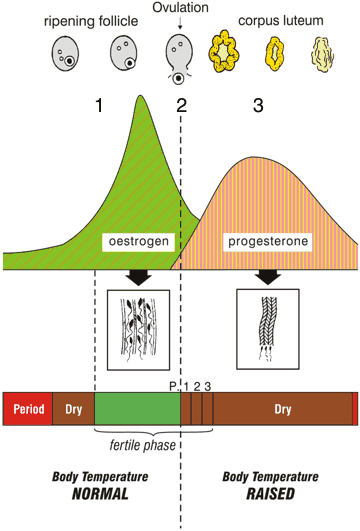understanding your fertility, page 12 of 14
Understanding the Hormone Pattern of the Cycle
None of the events of the cycle happen by chance. They are all controlled by chemical messengers called hormones. The two main hormones in a woman’s cycle - oestrogen and progesterone - are explained in the diagram below.

1. oestrogen comes in increasing amounts from the ripening egg follicle and causes the cervix to open and secrete fertile “motorway” mucus till the egg is ready for release. The last day of fertile mucus is called Peak Day - peak of fertility.
2. The dotted vertical line represents luteinizing hormone (lh) which triggers ovulation.
3. The empty follicle converts to a yellow structure, the corpus luteum - and produces the dominant hormone progesterone which:
- glues up the mucus,
- builds up the womb lining,
- stops all further ovulation in that cycle.
Allowing three days after Peak Day, for the mucus to thicken, all the remaining days of the cycle are infertile until the start of the next period.
The event of ovulation can also be confirmed by another sign - a rise in body temperature. This well researched method has been used world-wide with great success since the 1950’s, as a natural means of family planning.
effects of fertility on body temperature
Before ovulation a woman’s body temperature is normal, because oestrogen has no effect on body temperature.
However, after ovulation, progesterone in her body causes her temperature to rise and remain high till the next period starts. This is explained in the next illustration.
- Previous |
- Next |
- Exit Tutorial |
- Help |
- Download as a PDF
© 2007 Fertility Education Trust